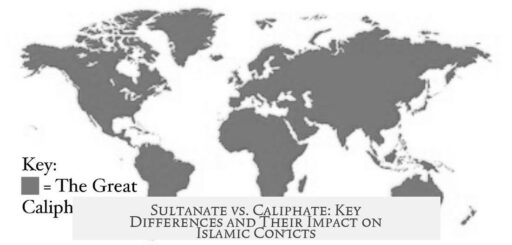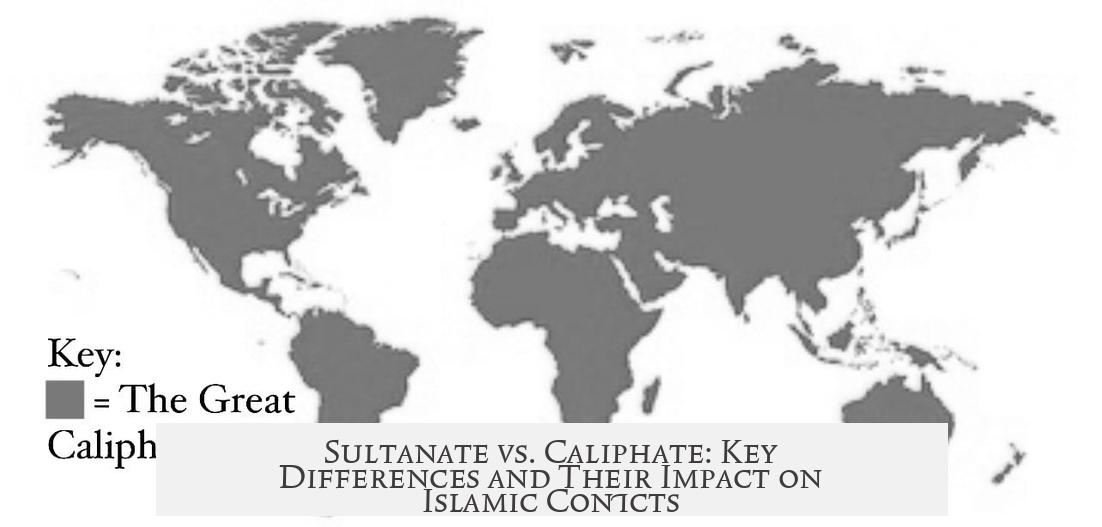The difference between a Sultanate and a Caliphate centers on their nature of authority: a Caliphate claims religious, moral, and political leadership of the entire Muslim community as the successor of Prophet Muhammad, implying divine sanction; whereas a Sultanate denotes secular political rule, often under the nominal religious authority of a Caliph.
The title Caliph (Khalifah) carries a religious mandate. It integrates spiritual and temporal leadership for Muslims. The Caliph is recognized as the supreme leader of the Ummah, embodying both governance and religious guidance. This dual role is unique and claims divine approval, commanding broad allegiance.
In contrast, the title Sultan is a political designation referring to a sovereign ruler or governor of a territory. The Sultan exercises temporal power and control over land and people but does not inherently claim supreme religious authority. Historically, Sultans often accepted the spiritual primacy of the Caliph while acting as de facto independent rulers.
Early Islamic history illustrates this distinction well. The initial Caliphate, under the Rightly Guided Caliphs, ruled centralized territories with governors (Wali) operating under direct Caliphal control. These governors served both civil and military roles, implementing religious law and taxing populations accordingly.
During the Umayyad period, the Caliphate expanded significantly, incorporating many non-Arabs. To manage vast territories, the strict hierarchical system loosened. Governors gained increased autonomy, especially in fiscal and administrative matters. The Umayyads shifted succession from election to dynastic inheritance, deepening the politicization of the Caliphate.
The Abbasid era saw further fragmentation. Regional powers broke away or rival states arose, weakening centralized Caliphal control. The Buyids took Baghdad, reducing the Caliph to a vassal with spiritual authority only. Similarly, the Ghaznavids carved out eastern domains, ruling independently but nominally recognizing the Caliph.
The Seljuk Turks intervened by capturing Baghdad at the Caliph’s request, restoring some centralized power. However, they retained actual political control while respecting the Caliph’s symbolic religious leadership. This arrangement effectively relegated the Caliph to a figurehead, with the Sultan wielding secular power.
Conflicts emerged from these overlapping roles and claims. The fundamental question was whether the Caliph’s spiritual supremacy could coexist with a subordinate secular power claiming autonomous rule. Rival Caliphates, like the Fatimids in North Africa, rejected Abbasid authority, deepening sectarian and political divides. Likewise, the remnants of the Umayyads in Iberia rejected Abbasid and later Fatimid claims.
Jurist al-Mawardi addressed this dilemma by articulating a doctrine legitimizing the Caliph as the universal religious leader who could delegate political authority to rulers like Sultans. This jurisprudence provided a theoretical foundation for recognizing independent rulers while preserving the Caliph’s spiritual primacy and unifying Islamic law.
Al-Mawardi also challenged rival claims to the Caliphate. For example, he opposed the Fatimid assertion that descent alone made one entitled to the Caliphate, emphasizing merit and political reality. He countered claims that only Qurayshi lineage justified leadership, indirectly contesting regimes led by non-Arabs such as the Buyids.
The recognition of the title Sultan began formally with the Ghaznavids to signal their independent status. The Seljuks solidified this by receiving explicit support from the Abbasid Caliphate, symbolizing a balance where religious authority remained centralized but political authority was decentralized. Over time, many Muslim rulers adopted the Sultan title to declare autonomy while acknowledging the Caliph’s religious role.
| Aspect | Caliphate | Sultanate |
|---|---|---|
| Authority | Religious, moral, and political leader of all Muslims | Secular ruler with political autonomy |
| Source of Legitimacy | Successor of Prophet Muhammad; divine approval | Political/military power often derived from de facto autonomy |
| Role Overlap | Claims universal spiritual leadership | Govern territories, sometimes under nominal Caliph authority |
| Historical Conflicts | Schisms over Caliphate legitimacy (Sunni vs. Shia); rivalry with rival Caliphates | Struggles for independence; tensions regarding subordination to Caliph |
In summary, the Caliphate and Sultanate differ fundamentally in their scope and source of authority. These differences fueled notable historical conflicts in Islam. The struggle for religious legitimacy and political control shaped Islamic history from early Caliphates to medieval Sultanates. Understanding this distinction clarifies key dynamics of Islamic governance and sectarian divides.
- The Caliphate claims combined religious and political leadership; the Sultanate claims primarily political rule.
- Early Caliphates centralized power; Sultanates emerged as autonomous regional rulers under nominal Caliphal authority.
- Jurists like al-Mawardi legitimized delegation of secular power to Sultans while preserving Caliphal spiritual supremacy.
- Political fragmentation and rival Caliphates caused significant sectarian and territorial conflicts.
- The Sultanate title signaled autonomy but partly recognized the religious leadership of the Caliph.
What Exactly Is the Difference Between a Sultanate and a Caliphate, and Did These Differences Lead to Any Notable Conflicts in Islamic History?

The fundamental difference between a Sultanate and a Caliphate lies in the nature of authority: a Sultanate primarily denotes political or military rule, while a Caliphate embodies both religious and political leadership as a successor to the Prophet Muhammad. Both titles governed vast territories and peoples, but their roles, legitimacy, and conflicts unfolded quite differently through history.
Curious how this distinction shaped Islamic history? Let’s unravel the story behind these two key powers, their struggles, and the drama they sparked across centuries.
Setting the Stage: Sultan vs. Caliph
Imagine the Sultan as the practical boss—the ruler who controls land or a group of people. The term “Sultan” basically means “ruler” or “authority.” Originally, it’s a broad political label which has flexed meaning over time. A Sultan might be a governor or an independent sovereign, much like a CEO who sometimes answers to a board and sometimes doesn’t.
Now, the Caliph is a different ballgame. The word “Caliph” (or Khalifa) literally means “successor,” specifically the successor to the Prophet Muhammad. This isn’t just politics; the Caliph claims religious, moral, and divine authority over all Muslims. Think of a Caliph as both the spiritual leader and the head of state, combining religious sanctity with political power.
This divine claim makes the Caliphate unique. But does that mean a Sultan can’t wield political control? Spoiler alert: many did, sometimes creating friction with the Caliphate.
The Early Caliphate: Centralized and Sacred
Back in the day, early Caliphs ruled decisively. They appointed client rulers or governors—known as Wali—over conquered territories. These governors managed civil and military affairs, paid well to stay honest, and even enjoyed spoils of war. Strict religious codes shaped governance, such as rejecting flashy dress. This created a unified system with clear authority rooted in faith.
As the Islamic empire exploded, the early model began to strain. The Umayyad Caliphate (661–750 CE) introduced dynastic rule. Instead of election-style selection, Caliphs increasingly passed their position like a family heirloom. The Caliphate grew more bureaucratic, tolerating non-Arab Muslims but keeping them as second-class citizens — a decision with lasting social implications.
Governors gained more autonomy. They collected taxes and chose their administrators largely independent of Baghdad’s direct control. What once was a centralized authority turned into a decentralized patchwork.
Fragmentation and the Rise of Sultanates
Things got more complicated during the Abbasid Caliphate. Fragmentation took hold as local powers split off or formed rival states. The Caliph retained spiritual leadership but had less political control.
The Buyids even forced the Abbasid Caliph into vassal status after capturing Baghdad. In the East, the Ghaznavids carved out their own political dominions. Then the Seljuks stepped in. Acting as military champions for the Abbasids, they rescued Baghdad from Fatimid control and married into the Caliph’s family. Yet, this arrangement relegated the Caliph to a secondary role—spiritual figurehead, not political boss.
This delegation of power is where the Sultan really shines. The Ghaznavids were the first rulers explicitly titled Sultans, signaling independence but recognizing the Caliph’s religious authority. The Seljuks followed, ruling vast lands on behalf of the Caliph but answering only to themselves politically.
Why Did These Differences Cause Conflicts?
The main source of tension lies in the question: can the Caliph, supposedly the supreme spiritual and political leader, be subordinate to a Sultan? It’s like having the pope as a figurehead while a prince calls the shots politically.
This tension sparked internal dissent within the Muslim world. Competing claims to the Caliphate caused long-running disputes—most famously splitting Sunni and Shia Muslims. Rival Caliphates, like the Fatimids in Egypt, rejected Abbasid claims. Meanwhile, remnants of the Umayyads ruled in Iberia, ignoring Abbasid authority altogether.
Now enter al-Mawardi, a brilliant jurist who addressed this quandary head-on. He crafted a political theory validating the Caliph’s supreme religious status, but allowing the Caliph to “lend” secular authority to rulers like Sultans. This legitimized the de facto power of the Seljuks and others while maintaining the Caliph’s spiritual primacy.
Al-Mawardi’s ideas also involved strategic politics. He dismissed the Fatimid claim that bloodline alone made a Caliph superior. Contradicting Prophet Muhammad’s injunctions, he argued the Caliph must be Qurayshi—shoring up Sunni Arab legitimacy and undermining non-Arab rulers like the Buyids and Ghaznavids. A clever move to safeguard Abbasid prestige!
What About the Sultanate’s Autonomy?
Here’s the kicker: while the Sultan owes spiritual allegiance to the Caliph, in practice they often ruled independently. The title Sultan itself signals authority or strength—*no higher authority except the Caliph’s religious leadership*. Yet the Sultan wielded real political power and military strength.
Take the Seljuks—they not only defended the Caliphate but also managed taxation, military campaigns, and political appointments without direct Caliphal interference. Later powers like the Mamluks and Ottomans would even claim Caliphate legitimacy alongside Sultanate power, blurring these lines further.
So, What Does This Mean for Islamic History?
The Sultanate-Caliphate relationship shaped centuries of Islamic politics. Their overlapping and competing authorities caused notable conflicts and shifts in power dynamics. Civil wars, rival Caliphates, and sectarian divides all trace back to disputes over who holds ultimate authority—and in what combination of religious and political roles.
Beyond conflict, this division contributed to governance innovation. The Sultanate system allowed local rulers to pragmatically govern while still acknowledging a unifying religious authority in the Caliph. This arrangement, though fraught with tension, kept vast, diverse Islamic empires together for centuries.
Bringing It All Together
In summary, a Sultan is a political ruler—sometimes a governor, sometimes an independent sovereign—focused mainly on earthly governance. A Caliph claims religious and moral authority with political leadership as Muhammad’s successor. Over time, power devolved from the centralized Caliphate to autonomous Sultanates, leading to conflicts over legitimacy and authority.
Famous thinkers like al-Mawardi helped resolve these tensions by endorsing a hierarchical system where the Caliph holds spiritual supremacy, while Sultans retain secular power. This clever framework sustained Islamic governance despite fragmentation and rivalries.
Understanding this difference and its historical consequences enriches how we see Islamic political tradition—not as a neat monolith but a complex dance of power, faith, and human ambition. Who knew a title could carry so much weight and drama?
Want to Dive Deeper?
- Explore how the Ottoman Sultans declared themselves Caliphs, merging the roles.
- Read about Fatimid Shia Caliphate claims challenging Sunni Abbasids.
- Learn how modern Islamic political thought still debates the Caliphate’s role.
So, when you hear “Sultanate” vs. “Caliphate,” think about politics vs. religion, power vs. piety, and centuries of a fascinating tug-of-war that shaped the Muslim world’s destiny.




